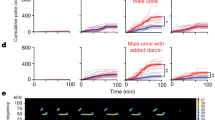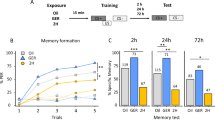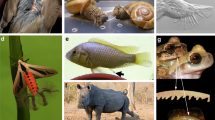Abstract
Recent insights have revolutionized our understanding of the importance of chemical signals in influencing vertebrate behaviour. Previously unknown families of pheromonal signals have been identified that are expanding the traditional definition of a pheromone. Although previously regarded as functioning independently, the main olfactory and vomeronasal systems have been found to have considerable overlap in terms of the chemosignals they detect and the effects that they mediate. Studies using gene-targeted mice have revealed an unexpected diversity of chemosensory systems and their underlying cellular and molecular mechanisms. Future developments could show how the functions of the different chemosensory systems are integrated to regulate innate and learned behavioural and physiological responses to pheromones.
This is a preview of subscription content, access via your institution
Access options
Subscribe to this journal
Receive 51 print issues and online access
$199.00 per year
only $3.90 per issue
Buy this article
- Purchase on Springer Link
- Instant access to full article PDF
Prices may be subject to local taxes which are calculated during checkout




Similar content being viewed by others
References
Karlson, P. & Lüscher, M. Pheromones: a new term for a class of biologically active substances. Nature 183, 55–56 (1959).
Schaal, B. et al. Chemical and behavioural characterization of the rabbit mammary pheromone. Nature 424, 68–72 (2003).
Novotny, M. V., Weidong, M., Wiesler, D. & Zidek, L. Positive identification of the puberty-accelerating pheromone of the house mouse: the volatile ligands associating with the major urinary protein. Proc. R. Soc. Lond. B 266, 2017–2022 (1999).
Wyatt, T. D. Pheromones and Animal Behaviour (Cambridge Univ. Press, Cambridge, 2003).
Yamazaki, K., Beauchamp, G. K., Curran, M. & Boyse, E. A. Parent–progeny recognition as a function of MHC odortype identity. Proc. Natl Acad. Sci. USA 97, 10500–10502 (2000).
Potts, W. K., Manning, C. J. & Wakeland, E. K. Mating patterns in seminatural populations of mice influenced by MHC genotype. Nature 352, 619–621 (1991).
Wysocki, C. & Preti, G. Facts, fallacies, fears and frustrations with human pheromones. Anat. Rec. A 281, 1201–1211 (2004).
Lin, D. Y., Zhang, S.-Z., Block, E. & Katz, L. C. Encoding social signals in the mouse main olfactory bulb. Nature 434, 470–477 (2005).
Kikuyama, S. et al. Sodefrin: a female-attracting peptide pheromone in newt cloacal glands. Science 267, 1643–1645 (1995).
Spehr, M. et al. Essential role of the main olfactory system in social recognition of major histocompatibility complex peptide ligands. J. Neurosci. 26, 1961–1970 (2006).
Boehm, T. & Zufall, F. MHC peptides and the sensory evaluation of genotype. Trends Neurosci. 29, 100–107 (2006).
Leinders-Zufall, T. et al. MHC class I peptides as chemosensory signals in the vomeronasal organ. Science 306, 1033–1037 (2004).
Hurst, J. L. et al. Individual recognition in mice mediated by major urinary proteins. Nature 414, 631–634 (2001).
Morè, L. Mouse major urinary proteins trigger ovulation via the vomeronasal organ. Chem. Senses 31, 393–401 (2006).
Kimoto, H., Haga, S., Sato, K. & Touhara, K. Sex-specific peptides from exocrine glands stimulate mouse vomeronasal sensory neurons. Nature 437, 898–901 (2005).
Sorensen, P. et al. Mixture of new sulfated steroids functions as a migratory pheromone in the sea lamprey. Nature Chem. Biol. 1, 324–328 (2005).
Dorries, K. M., Adkins, R. E. & Halpern, B. P. Sensitivity and behavioral responses to the pheromone androstenone are not mediated by the vomeronasal organ in domestic pigs. Brain Behav. Evol. 49, 53–62 (1997).
Novotny, M. V. Pheromones, binding proteins and receptor responses in rodents. Biochem. Soc. Trans. 31, 117–122 (2003).
Zhang, X. & Firestein, S. The olfactory receptor gene superfamily of the mouse. Nature Neurosci. 5, 124–133 (2002).
Liberles, S. D. & Buck, L. B. A second class of chemosensory receptors in the olfactory epithelium. Nature 42, 645–650 (2006).
Halpern, M. & Martínez-Marcos, A. Structure and function of the vomeronasal system: an update. Prog. Neurobiol. 70, 245–318 (2003).
Dulac, C. & Torello, A. T. Molecular detection of pheromone signals in mammals: from genes to behaviour. Nature Rev. Neurosci. 4, 551–562 (2003).
Del Punta, K. et al. Deficient pheromone responses in mice lacking a cluster of vomeronasal receptor genes. Nature 419, 70–74 (2002).
Lucas, P., Ukhanov, K., Leinders-Zufall, T. & Zufall, F. A diacylglycerol-gated cation channel in vomeronasal neuron dendrites is impaired in TRPC2 mutant mice: mechanism of pheromone transduction. Neuron 40, 551–561 (2003).
Rodriguez, I., Del Punta, K., Rothman, A., Ishii, T. & Mombaerts, P. Multiple new and isolated families within the mouse superfamily of V1r vomeronasal receptors. Nature Neurosci. 5, 134–140 (2002).
Yang, H., Shi, P., Zhang, Y. & Zhang, J. Composition and evolution of the V2r vomeronasal receptor gene repertoire in mice and rats. Genomics 86, 306–315 (2005).
Hansen, A., Anderson, K. & Finger, T. Differential distribution of olfactory receptor neurons in goldfish: structural and molecular correlates. J. Comp. Neurol. 477, 347–359 (2004).
Pfister, P. & Rodriguez, I. Olfactory expression of a single and highly variable V1r pheromone receptor-like gene in fish species. Proc. Natl Acad. Sci. USA 102, 5489–5494 (2005).
Eisthen, H. The goldfish knows: olfactory receptor cell morphology predicts receptor gene expression. J. Comp. Neurol. 477, 341–346 (2004).
Elsaesser, R., Montani, G., Tirindelli, R. & Paysan, J. Phosphatidyl-inositide signalling proteins in a novel class of sensory cells in the mammalian olfactory epithelium. Eur. J. Neurosci. 21, 2692–2700 (2005).
Meredith, M. Chronic recording of vomeronasal pump activation in awake behaving hamsters. Physiol. Behav. 56, 345–354 (1994).
Leinders-Zufall, T. et al. Ultrasensitive pheromone detection by mammalian vomeronasal neurons. Nature 405, 792–796 (2000).
Sam, M. et al. Odorants may arouse instinctive behaviours. Nature 412, 142 (2001).
Boschat, C. et al. Pheromone detection mediated by a V1r vomeronasal receptor. Nature Neurosci. 5, 1261–1262 (2002).
Sharrow, S., Vaughn, J., Zídek, L., Novotny, M. & Stone, M. Pheromone binding by polymorphic mouse major urinary proteins. Protein Sci. 11, 2247–2256 (2002).
Luo, M. M., Fee, M. S. & Katz, L. C. Encoding pheromonal signals in the accessory olfactory bulb of behaving mice. Science 299, 1196–1201 (2003).
Xu, F. et al. Simultaneous activation of the mouse main and accessory olfactory bulbs by odors or pheromones. J. Comp. Neurol. 489, 491–500 (2005).
Wysocki, C. J. & Lepri, J. L. Consequences of removing the vomeronasal organ. J. Steroid Biochem. Mol. Biol. 39, 661–669 (1991).
Stowers, L., Holy, T. E., Meister, M., Dulac, C. & Koentges, G. Loss of sex discrimination and male–male aggression in mice deficient for TRP2. Science 295, 1493–1500 (2002).
Leypold, B. G. et al. Altered sexual and social behaviors in trp2 mutant mice. Proc. Natl Acad. Sci. USA 99, 6376–6381 (2002).
Kelliher, K., Spehr, M., Li, X.-H., Zufall, F. & Leinders-Zufall, T. Pheromonal recognition memory induced by TRPC2-independent vomeronasal sensing. Eur. J. Neurosci. 23, 3385–3390 (2006).
Hudson, R. & Distel, H. Pheromonal release of suckling in rabbits does not depend on the vomeronasal organ. Physiol. Behav. 37, 123–129 (1986).
Mandiyan, V., Coats, J. & Shah, N. Deficits in aggressive behaviors in Cnga2 mutant mice. Nature Neurosci. 8, 1660–1662 (2005).
Hurst, J. & Beynon, R. Scent wars: the chemobiology of competitive signalling in mice. BioEssays 26, 1288–1298 (2004).
Zufall, F. & Munger, S. From odor and pheromone transduction to the organization of the sense of smell. Trends Neurosci. 24, 191–193 (2001).
Ma, M. et al. Olfactory signal transduction in the mouse septal organ. J. Neurosci. 23, 317–324 (2003).
Fuss, S., Omura, M. & Mombaerts, P. The Grueneberg ganglion of the mouse projects axons to glomeruli in the olfactory bulb. Eur. J. Neurosci. 22, 2649–2654 (2005).
Jordan, W. C. & Bruford, M. W. New perspectives on mate choice and the MHC. Heredity 81, 127–133 (1998).
Boyse, E. A., Beauchamp, G. K. & Yamazaki, K. The genetics of body scent. Trends Genet. 3, 97–102 (1987).
Carroll, L. S., Penn, D. J. & Potts, W. K. Discrimination of MHC-derived odors by untrained mice is consistent with divergence in peptide-binding region residues. Proc. Natl Acad. Sci. USA 99, 2187–2192 (2002).
Singh, P. B., Brown, R. E. & Roser, B. MHC antigens in urine as olfactory recognition cues. Nature 327, 161–164 (1987).
Singh, P. B. Chemosensation and genetic individuality. Reproduction 121, 529–539 (2001).
Schaefer, M. L., Yamazaki, K., Osada, K., Restrepo, D. & Beauchamp, G. K. Olfactory fingerprints for major histocompatibility complex-determined body odors II: relationship among odor maps, genetics, odor composition, and behavior. J. Neurosci. 22, 9513–9521 (2002).
Loconto, J. et al. Functional expression of murine V2R pheromone receptors involves selective association with the M10 and M1 families of MHC class 1b molecules. Cell 112, 607–618 (2003).
Ishii, T., Hirota, J. & Mombaerts, P. Combinational coexpression of neural and immune multigene families in mouse vomeronasal sensory systems. Curr. Biol. 13, 394–400 (2003).
Olson, R., Huey-Tubman, K., Dulac, C. & Bjorkman, P. Structure of a pheromone receptor-associated MHC molecule with an open and empty groove. PLoS 3, e257 (2005).
Milinski, M. et al. Mate choice decisions of stickleback females predictably modified by MHC peptide ligands. Proc. Natl Acad. Sci. USA 102, 4414–4418 (2005).
Flower, D. R. The lipocalin protein family: structure and function. Biochem. J. 318, 1–14 (1996).
Armstrong, S., Robertson, D., Cheetham, S., Hurst, J. & Beynon, R. Structural and functional differences in isoforms of mouse major urinary proteins: a male-specific protein that preferentially binds a male pheromone. Biochem. J. 391, 343–350 (2005).
Beynon, R. et al. Polymorphism in major urinary proteins: molecular heterogeneity in a wild mouse population. J. Chem. Ecol. 28, 1429–1446 (2002).
Luo, M. & Katz, L. Encoding pheromonal signals in the mammalian vomeronasal system. Curr. Opin. Neurobiol. 14, 428–434 (2004).
Sugai, T., Sugitani, M. & Onoda, N. Subdivisions of the guinea pig accessory olfactory bulb revealed by the combined method with immunohistochemistry, electrophysiological, and optical recordings. Neuroscience 79, 871–885 (1997).
Boehm, U., Zou, Z. & Buck, L. Feedback loops link odor and pheromone signaling with reproduction. Cell 123, 683–695 (2005).
Yoon, H., Enquist, L. & Dulac, C. Olfactory inputs to hypothalamic neurons controlling reproduction and fertility. Cell 123, 669–695 (2005).
Kaba, H. & Nakanishi, S. Synaptic mechanisms of olfactory recognition memory. Rev. Neurosci. 6, 125–141 (1995).
Halem, H. A., Cherry, J. A. & Baum, M. J. Central forebrain responses to familiar male odors are attenuated in recently mated female mice. Eur. J. Neurosci. 13, 389–399 (2001).
Binns, K. E. & Brennan, P. A. Changes in electrophysiological activity in the accessory olfactory bulb and medial amygdala associated with mate recognition in mice. Eur. J. Neurosci. 21, 2529–2537 (2005).
Yamazaki, K. et al. Familial imprinting determines H-2 selective mating preferences. Science 240, 1331–1332 (1988).
Penn, D. & Potts, W. MHC-disassortative mating preferences reversed by cross-fostering. Proc. R. Soc. Lond. B 265, 1299–1306 (1998).
Hudson, R. Do newborn rabbits learn the odor stimuli releasing nipple-search behavior? Dev. Psychobiol. 18, 575–585 (1985).
Moncho-Bogani, J., Martinez-Garcia, F., Novejarque, A. & Lanuza, E. Attraction to sexual pheromones and associated odorants in female mice involves activation of the reward system and basolateral amygdala. Eur. J. Neurosci. 21, 2186–2198 (2005).
Meredith, M. Vomeronasal, olfactory, hormonal convergence in the brain. Ann. NY Acad. Sci. 855, 349–361 (1998).
Mitchell, J. & Gratton, A. Opioid modulation and sensization of dopamine release elicited by sexually relevant stimuli: a high speed chronoamperometric study in freely behaving rats. Brain Res. 551, 20–27 (1991).
West, C., Clancy, A. & Michael, R. Enhanced responses of nucleus accumbens neurons in male rats to novel odors associated with sexually receptive females. Brain Res. 585, 49–55 (1992).
Kippin, T., Cain, S. & Pfaus, J. Estrous odors and sexually conditioned neutral odors activate separate neural pathways in the male rat. Neuroscience 117, 971–979 (2003).
Meredith, M. & Westberry, J. M. Distinctive responses in the medial amygdala to same-species and different-species pheromones. J. Neurosci. 24, 5719–5725 (2004).
Choi, G. B. et al. Lhx6 delineates a pathway mediating innate reproductive behaviors from the amygdala to the hypothalamus. Neuron 46, 647–660 (2005).
Ferguson, J. N., Aldag, J. M., Insel, T. R. & Young, L. J. Oxytocin in the medial amygdala is essential for social recognition in the mouse. J. Neurosci. 21, 8278–8285 (2001).
Keller, M., Perrin, G., Meurisse, M., Ferreira, G. & Lévy, F. Cortical and medial amygdala are both involved in the formation of olfactory offspring memory in sheep. Eur. J. Neurosci. 20, 3433–3441 (2004).
Leyden, J., McGinley, K., Hölzle, E., Labows, J. & Kligman, A. The microbiology of the human axilla and its relationship to axillary odor. J. Invest. Dermatol. 77, 413–416 (1981).
Zeng, X.-N. et al. Analysis of characteristic odors from human male axillae. J. Chem. Ecol. 17, 1469–1492 (1991).
Zeng, C. et al. A human axillary odorant is carried by apolipoprotein D. Proc. Natl Acad. Sci. USA 93, 6626–6630 (1996).
Witt, M. & Hummel, T. Vomeronasal versus olfactory epithelium: is there a cellular basis for human vomeronasal perception? Int. Rev. Cytol. 248, 209–259 (2006).
Meredith, M. Human vomeronasal organ function: a critical review of best and worst cases. Chem. Senses 26, 433–445 (2001).
Zhang, J. & Webb, D. Evolutionary deterioration of the vomeronasal pheromone transduction pathway in catarrhine primates. Proc. Natl Acad. Sci. USA 100, 8337–8341 (2003).
Liman, E. R. & Innan, H. Relaxed selective pressure on an essential component of pheromone transduction in primate evolution. Proc. Natl Acad. Sci. USA 100, 3328–3332 (2003).
Kouros-Mehr, H. et al. Identification of non-functional human VNO receptor genes provides evidence for vestigiality of the human VNO. Chem. Senses 26, 1167–1174 (2001).
Rodriguez, I. & Mombaerts, P. Novel human vomeronasal receptor-like genes reveal species-specific families. Curr. Biol. 12, R409–R411 (2002).
Rodriguez, I., Greer, C. A., Mok, M. Y. & Mombaerts, P. A putative pheromone receptor gene expressed in human olfactory mucosa. Nature Genet. 26, 18–19 (2000).
Stern, K. & McClintock, M. K. Regulation of ovulation by human pheromones. Nature 392, 177–179 (1998).
Preti, G., Wysocki, C., Barnhart, K., Sondheimer, S. & Leyden, J. Male axillary extracts contain pheromones that affect pulsatile secretion of luteinizing hormone and mood in women recipients. Biol. Reprod. 68, 2107–2113 (2003).
Wedekind, C. & Furi, S. Body odour preferences in men and women: do they aim for specific MHC combinations or simply heterozygosity? Proc. R. Soc. Lond. B 264, 1471–1479 (1997).
Jacob, S., McClintock, M. K., Zelano, B. & Ober, C. Paternally inherited HLA alleles are associated with women's choice of male odor. Nature Genet. 30, 175–179 (2002).
Ober, C. et al. HLA and mate choice in humans. Am. J. Hum. Genet. 61, 497–504 (1997).
Varendi, H. & Porter, R. H. Breast odour as the only maternal stimulus elicits crawling towards the odour source. Acta Paediatr. 90, 372–375 (2001).
Jacob, S. & McClintock, M. Pyschological state and mood effects of steroidal chemosignals in women and men. Horm. Behav. 37, 57–78 (2000).
Savic, I., Berglund, H., Gulyas, B. & Roland, P. Smelling of odorous sex hormone-like compounds causes sex-differentiated hypothalamic activations in humans. Neuron 31, 661–668 (2001).
Keverne, E. Odor here, odor there: chemosensation and reproductive function. Nature Neurosci. 8, 1637–1638 (2005).
Brennan, P. A., Kendrick, K. M. & Keverne, E. B. Neurotransmitter release in the accessory olfactory bulb during and after the formation of an olfactory memory in mice. Neuroscience 69, 1075–1086 (1995).
Pitkänen, A. in The Amygdala: a Functional Analysis (ed. Aggleton, J.) 31–115 (Oxford University Press, Oxford, 2000).
Acknowledgements
In memory of L. C. Katz. This review and our research were supported by grants from the NIH/NIDCD (F.Z.) and the MRC/BBSRC (P.A.B.). Apologies to our colleagues whose work we could not cite owing to space limitations.
Author information
Authors and Affiliations
Corresponding authors
Ethics declarations
Competing interests
The authors declare no competing financial interests.
Additional information
Author Information Reprints and permissions information is available at npg.nature.com/reprintsandpermissions.
Rights and permissions
About this article
Cite this article
Brennan, P., Zufall, F. Pheromonal communication in vertebrates. Nature 444, 308–315 (2006). https://doi.org/10.1038/nature05404
Published:
Issue Date:
DOI: https://doi.org/10.1038/nature05404
This article is cited by
-
CD20/MS4A1 is a mammalian olfactory receptor expressed in a subset of olfactory sensory neurons that mediates innate avoidance of predators
Nature Communications (2024)
-
Characterization of the microbiome and volatile compounds in anal gland secretions from domestic cats (Felis catus) using metagenomics and metabolomics
Scientific Reports (2023)
-
Robust odor identification in novel olfactory environments in mice
Nature Communications (2023)
-
Community structure of the solitary giant pandas is maintained by indirect social connections
Movement Ecology (2022)
-
Loss of Neuropilin2a/b or Sema3fa alters olfactory sensory axon dynamics and protoglomerular targeting
Neural Development (2022)
Comments
By submitting a comment you agree to abide by our Terms and Community Guidelines. If you find something abusive or that does not comply with our terms or guidelines please flag it as inappropriate.



